Human Resource Management Report: BT's HRM Practices and Effectiveness
VerifiedAdded on 2020/09/08
|20
|5857
|68
Report
AI Summary
This report provides a comprehensive analysis of Human Resource Management (HRM) practices, focusing on British Telecom (BT) as a case study. The report begins with an introduction to HRM, outlining its core functions such as recruitment, selection, orientation, employee relations, and training and development. It then delves into the purpose and functions of HRM in workforce planning, exploring the strengths and weaknesses of different recruitment and selection approaches. The report further examines the benefits of various HRM practices for both employers and employees, including performance appraisal, hiring strategies, and training programs. It also addresses the importance of employee relations and the impact of employee legislation on HRM decision-making. The report concludes by analyzing HRM practices within an enterprise context, emphasizing their application and effectiveness in achieving organizational goals. The report uses both the Hard and Soft HRM approaches. The report provides in-depth analysis of the HRM processes that contribute to the effectiveness of BT's workforce management strategies.
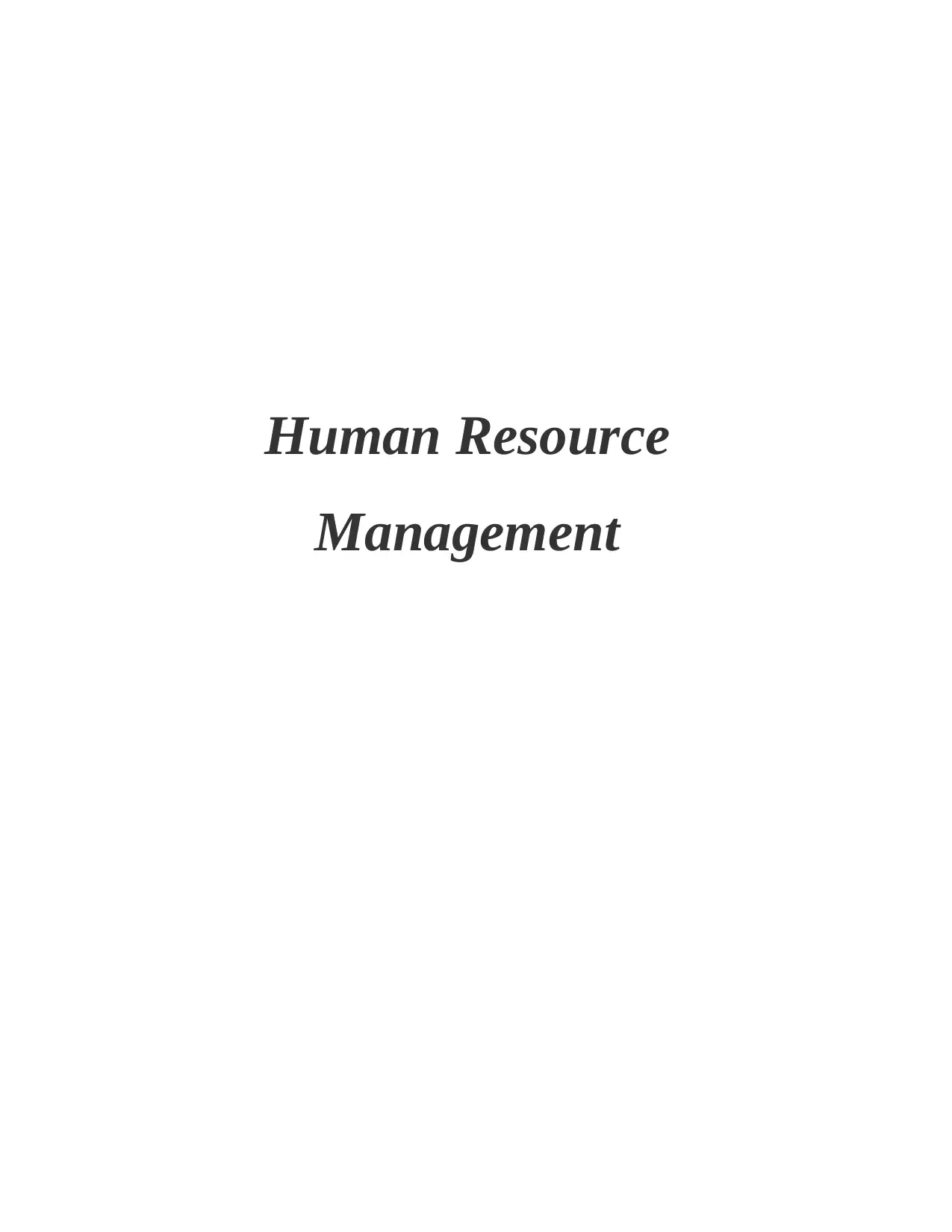
Human Resource
Management
Management
Paraphrase This Document
Need a fresh take? Get an instant paraphrase of this document with our AI Paraphraser
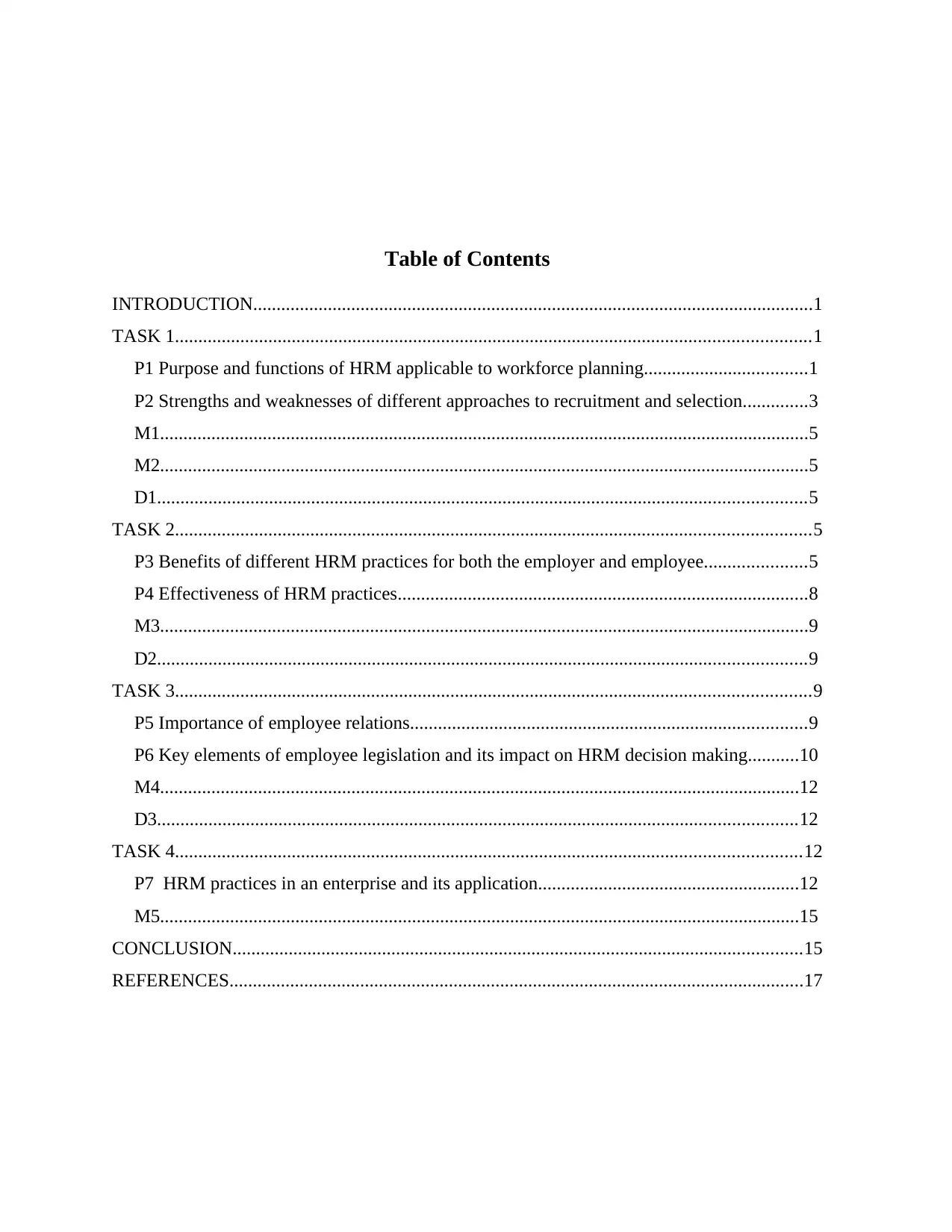
Table of Contents
INTRODUCTION........................................................................................................................1
TASK 1........................................................................................................................................1
P1 Purpose and functions of HRM applicable to workforce planning...................................1
P2 Strengths and weaknesses of different approaches to recruitment and selection..............3
M1...........................................................................................................................................5
M2...........................................................................................................................................5
D1...........................................................................................................................................5
TASK 2........................................................................................................................................5
P3 Benefits of different HRM practices for both the employer and employee......................5
P4 Effectiveness of HRM practices........................................................................................8
M3...........................................................................................................................................9
D2...........................................................................................................................................9
TASK 3........................................................................................................................................9
P5 Importance of employee relations.....................................................................................9
P6 Key elements of employee legislation and its impact on HRM decision making...........10
M4.........................................................................................................................................12
D3.........................................................................................................................................12
TASK 4......................................................................................................................................12
P7 HRM practices in an enterprise and its application........................................................12
M5.........................................................................................................................................15
CONCLUSION..........................................................................................................................15
REFERENCES...........................................................................................................................17
INTRODUCTION........................................................................................................................1
TASK 1........................................................................................................................................1
P1 Purpose and functions of HRM applicable to workforce planning...................................1
P2 Strengths and weaknesses of different approaches to recruitment and selection..............3
M1...........................................................................................................................................5
M2...........................................................................................................................................5
D1...........................................................................................................................................5
TASK 2........................................................................................................................................5
P3 Benefits of different HRM practices for both the employer and employee......................5
P4 Effectiveness of HRM practices........................................................................................8
M3...........................................................................................................................................9
D2...........................................................................................................................................9
TASK 3........................................................................................................................................9
P5 Importance of employee relations.....................................................................................9
P6 Key elements of employee legislation and its impact on HRM decision making...........10
M4.........................................................................................................................................12
D3.........................................................................................................................................12
TASK 4......................................................................................................................................12
P7 HRM practices in an enterprise and its application........................................................12
M5.........................................................................................................................................15
CONCLUSION..........................................................................................................................15
REFERENCES...........................................................................................................................17

⊘ This is a preview!⊘
Do you want full access?
Subscribe today to unlock all pages.

Trusted by 1+ million students worldwide
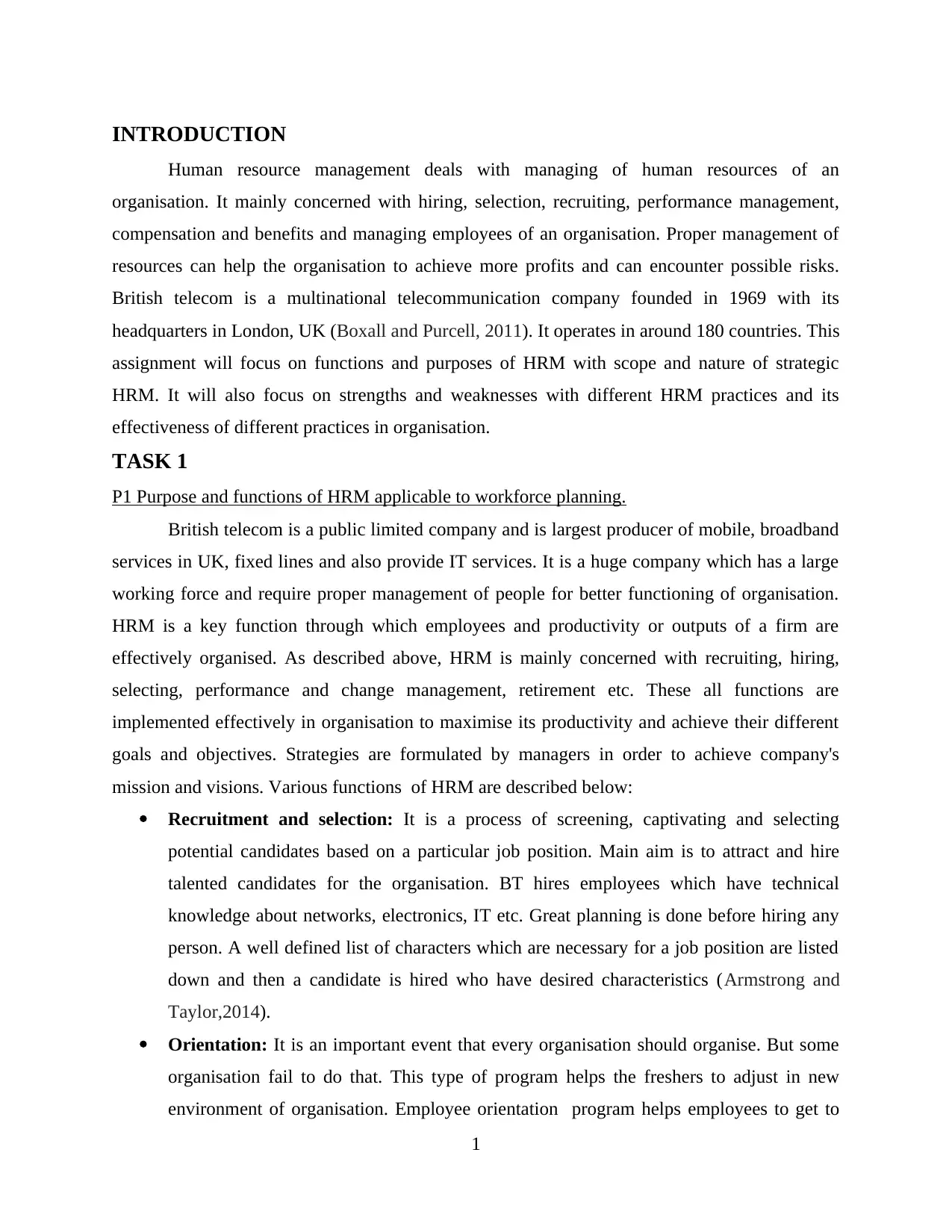
INTRODUCTION
Human resource management deals with managing of human resources of an
organisation. It mainly concerned with hiring, selection, recruiting, performance management,
compensation and benefits and managing employees of an organisation. Proper management of
resources can help the organisation to achieve more profits and can encounter possible risks.
British telecom is a multinational telecommunication company founded in 1969 with its
headquarters in London, UK (Boxall and Purcell, 2011). It operates in around 180 countries. This
assignment will focus on functions and purposes of HRM with scope and nature of strategic
HRM. It will also focus on strengths and weaknesses with different HRM practices and its
effectiveness of different practices in organisation.
TASK 1
P1 Purpose and functions of HRM applicable to workforce planning.
British telecom is a public limited company and is largest producer of mobile, broadband
services in UK, fixed lines and also provide IT services. It is a huge company which has a large
working force and require proper management of people for better functioning of organisation.
HRM is a key function through which employees and productivity or outputs of a firm are
effectively organised. As described above, HRM is mainly concerned with recruiting, hiring,
selecting, performance and change management, retirement etc. These all functions are
implemented effectively in organisation to maximise its productivity and achieve their different
goals and objectives. Strategies are formulated by managers in order to achieve company's
mission and visions. Various functions of HRM are described below:
Recruitment and selection: It is a process of screening, captivating and selecting
potential candidates based on a particular job position. Main aim is to attract and hire
talented candidates for the organisation. BT hires employees which have technical
knowledge about networks, electronics, IT etc. Great planning is done before hiring any
person. A well defined list of characters which are necessary for a job position are listed
down and then a candidate is hired who have desired characteristics (Armstrong and
Taylor,2014).
Orientation: It is an important event that every organisation should organise. But some
organisation fail to do that. This type of program helps the freshers to adjust in new
environment of organisation. Employee orientation program helps employees to get to
1
Human resource management deals with managing of human resources of an
organisation. It mainly concerned with hiring, selection, recruiting, performance management,
compensation and benefits and managing employees of an organisation. Proper management of
resources can help the organisation to achieve more profits and can encounter possible risks.
British telecom is a multinational telecommunication company founded in 1969 with its
headquarters in London, UK (Boxall and Purcell, 2011). It operates in around 180 countries. This
assignment will focus on functions and purposes of HRM with scope and nature of strategic
HRM. It will also focus on strengths and weaknesses with different HRM practices and its
effectiveness of different practices in organisation.
TASK 1
P1 Purpose and functions of HRM applicable to workforce planning.
British telecom is a public limited company and is largest producer of mobile, broadband
services in UK, fixed lines and also provide IT services. It is a huge company which has a large
working force and require proper management of people for better functioning of organisation.
HRM is a key function through which employees and productivity or outputs of a firm are
effectively organised. As described above, HRM is mainly concerned with recruiting, hiring,
selecting, performance and change management, retirement etc. These all functions are
implemented effectively in organisation to maximise its productivity and achieve their different
goals and objectives. Strategies are formulated by managers in order to achieve company's
mission and visions. Various functions of HRM are described below:
Recruitment and selection: It is a process of screening, captivating and selecting
potential candidates based on a particular job position. Main aim is to attract and hire
talented candidates for the organisation. BT hires employees which have technical
knowledge about networks, electronics, IT etc. Great planning is done before hiring any
person. A well defined list of characters which are necessary for a job position are listed
down and then a candidate is hired who have desired characteristics (Armstrong and
Taylor,2014).
Orientation: It is an important event that every organisation should organise. But some
organisation fail to do that. This type of program helps the freshers to adjust in new
environment of organisation. Employee orientation program helps employees to get to
1
Paraphrase This Document
Need a fresh take? Get an instant paraphrase of this document with our AI Paraphraser
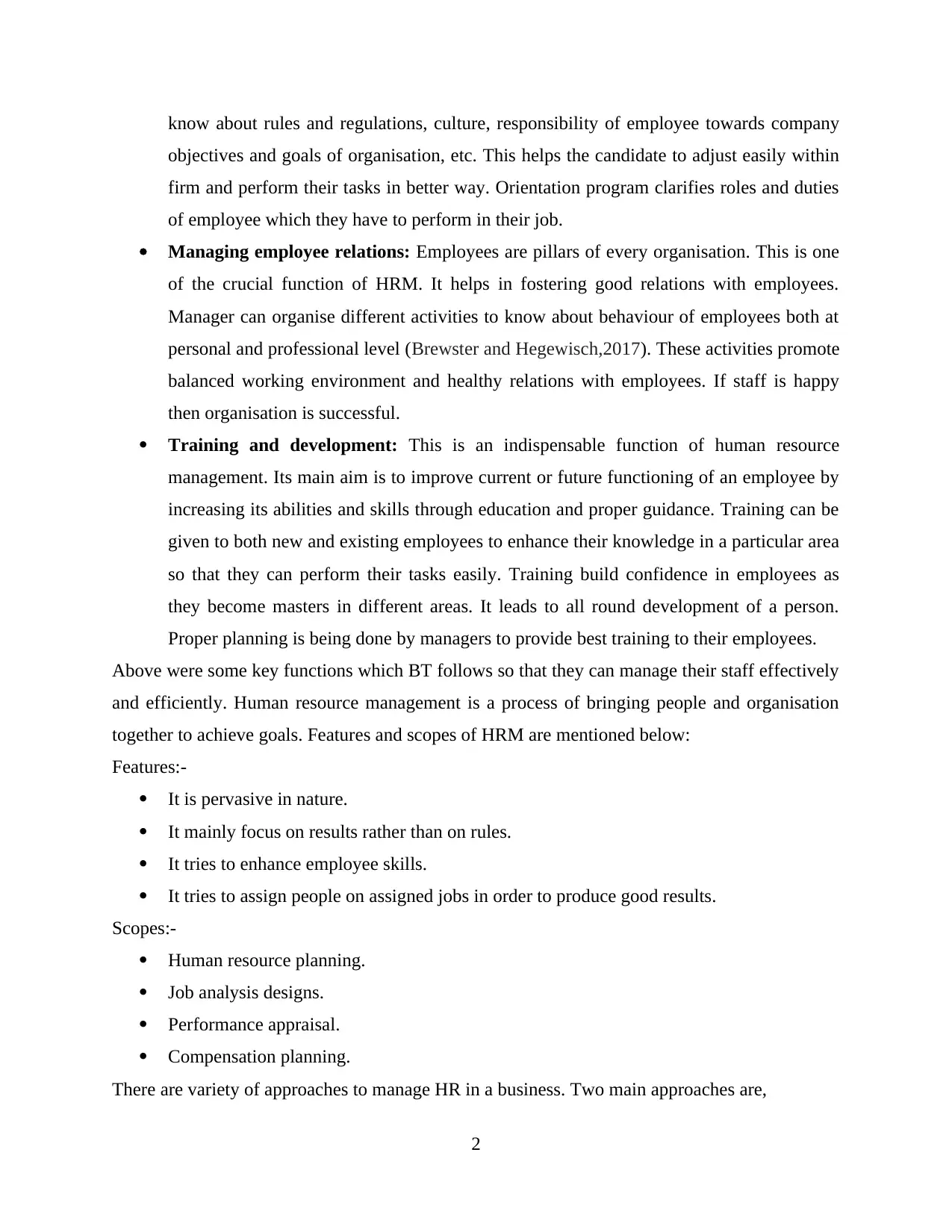
know about rules and regulations, culture, responsibility of employee towards company
objectives and goals of organisation, etc. This helps the candidate to adjust easily within
firm and perform their tasks in better way. Orientation program clarifies roles and duties
of employee which they have to perform in their job.
Managing employee relations: Employees are pillars of every organisation. This is one
of the crucial function of HRM. It helps in fostering good relations with employees.
Manager can organise different activities to know about behaviour of employees both at
personal and professional level (Brewster and Hegewisch,2017). These activities promote
balanced working environment and healthy relations with employees. If staff is happy
then organisation is successful.
Training and development: This is an indispensable function of human resource
management. Its main aim is to improve current or future functioning of an employee by
increasing its abilities and skills through education and proper guidance. Training can be
given to both new and existing employees to enhance their knowledge in a particular area
so that they can perform their tasks easily. Training build confidence in employees as
they become masters in different areas. It leads to all round development of a person.
Proper planning is being done by managers to provide best training to their employees.
Above were some key functions which BT follows so that they can manage their staff effectively
and efficiently. Human resource management is a process of bringing people and organisation
together to achieve goals. Features and scopes of HRM are mentioned below:
Features:-
It is pervasive in nature.
It mainly focus on results rather than on rules.
It tries to enhance employee skills.
It tries to assign people on assigned jobs in order to produce good results.
Scopes:-
Human resource planning.
Job analysis designs.
Performance appraisal.
Compensation planning.
There are variety of approaches to manage HR in a business. Two main approaches are,
2
objectives and goals of organisation, etc. This helps the candidate to adjust easily within
firm and perform their tasks in better way. Orientation program clarifies roles and duties
of employee which they have to perform in their job.
Managing employee relations: Employees are pillars of every organisation. This is one
of the crucial function of HRM. It helps in fostering good relations with employees.
Manager can organise different activities to know about behaviour of employees both at
personal and professional level (Brewster and Hegewisch,2017). These activities promote
balanced working environment and healthy relations with employees. If staff is happy
then organisation is successful.
Training and development: This is an indispensable function of human resource
management. Its main aim is to improve current or future functioning of an employee by
increasing its abilities and skills through education and proper guidance. Training can be
given to both new and existing employees to enhance their knowledge in a particular area
so that they can perform their tasks easily. Training build confidence in employees as
they become masters in different areas. It leads to all round development of a person.
Proper planning is being done by managers to provide best training to their employees.
Above were some key functions which BT follows so that they can manage their staff effectively
and efficiently. Human resource management is a process of bringing people and organisation
together to achieve goals. Features and scopes of HRM are mentioned below:
Features:-
It is pervasive in nature.
It mainly focus on results rather than on rules.
It tries to enhance employee skills.
It tries to assign people on assigned jobs in order to produce good results.
Scopes:-
Human resource planning.
Job analysis designs.
Performance appraisal.
Compensation planning.
There are variety of approaches to manage HR in a business. Two main approaches are,
2
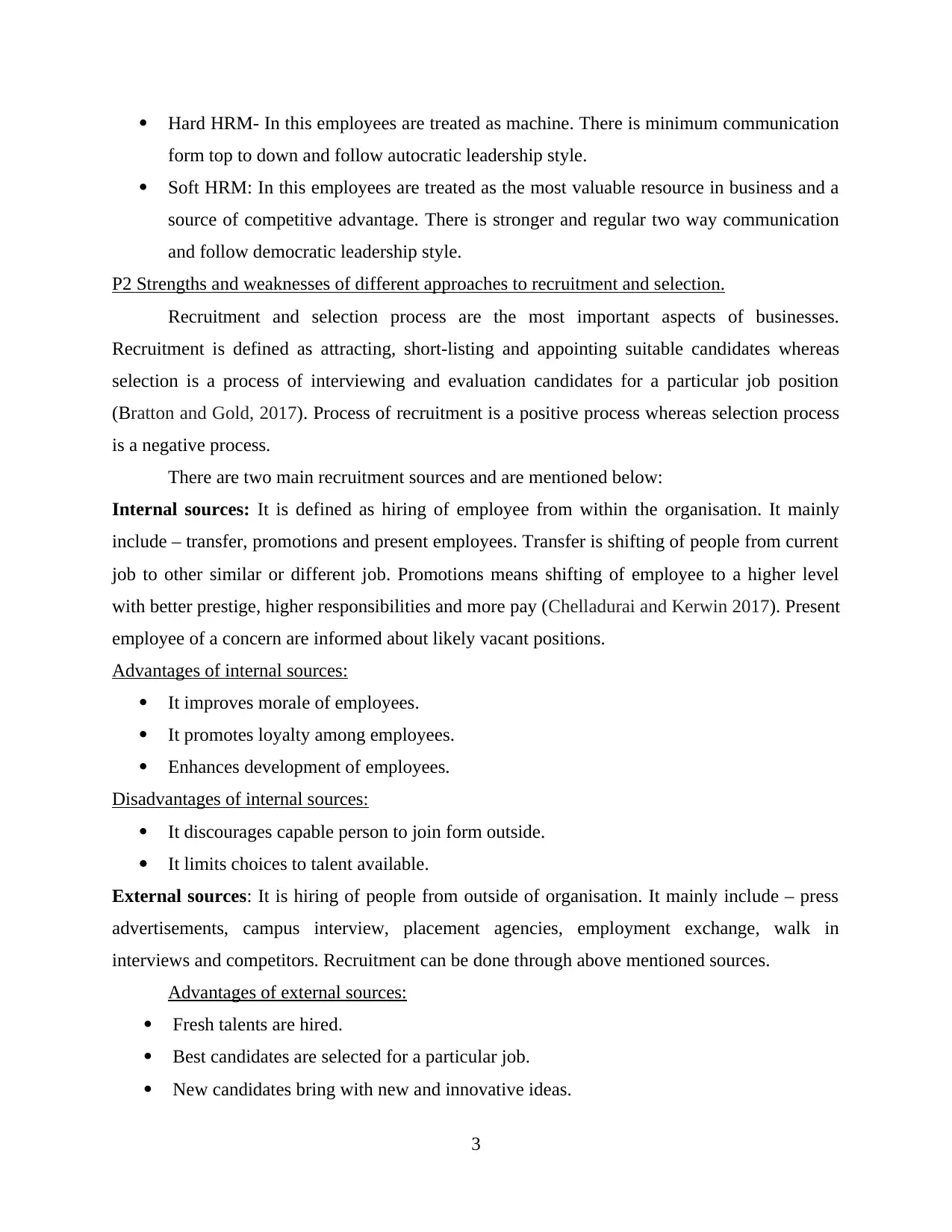
Hard HRM- In this employees are treated as machine. There is minimum communication
form top to down and follow autocratic leadership style.
Soft HRM: In this employees are treated as the most valuable resource in business and a
source of competitive advantage. There is stronger and regular two way communication
and follow democratic leadership style.
P2 Strengths and weaknesses of different approaches to recruitment and selection.
Recruitment and selection process are the most important aspects of businesses.
Recruitment is defined as attracting, short-listing and appointing suitable candidates whereas
selection is a process of interviewing and evaluation candidates for a particular job position
(Bratton and Gold, 2017). Process of recruitment is a positive process whereas selection process
is a negative process.
There are two main recruitment sources and are mentioned below:
Internal sources: It is defined as hiring of employee from within the organisation. It mainly
include – transfer, promotions and present employees. Transfer is shifting of people from current
job to other similar or different job. Promotions means shifting of employee to a higher level
with better prestige, higher responsibilities and more pay (Chelladurai and Kerwin 2017). Present
employee of a concern are informed about likely vacant positions.
Advantages of internal sources:
It improves morale of employees.
It promotes loyalty among employees.
Enhances development of employees.
Disadvantages of internal sources:
It discourages capable person to join form outside.
It limits choices to talent available.
External sources: It is hiring of people from outside of organisation. It mainly include – press
advertisements, campus interview, placement agencies, employment exchange, walk in
interviews and competitors. Recruitment can be done through above mentioned sources.
Advantages of external sources:
Fresh talents are hired.
Best candidates are selected for a particular job.
New candidates bring with new and innovative ideas.
3
form top to down and follow autocratic leadership style.
Soft HRM: In this employees are treated as the most valuable resource in business and a
source of competitive advantage. There is stronger and regular two way communication
and follow democratic leadership style.
P2 Strengths and weaknesses of different approaches to recruitment and selection.
Recruitment and selection process are the most important aspects of businesses.
Recruitment is defined as attracting, short-listing and appointing suitable candidates whereas
selection is a process of interviewing and evaluation candidates for a particular job position
(Bratton and Gold, 2017). Process of recruitment is a positive process whereas selection process
is a negative process.
There are two main recruitment sources and are mentioned below:
Internal sources: It is defined as hiring of employee from within the organisation. It mainly
include – transfer, promotions and present employees. Transfer is shifting of people from current
job to other similar or different job. Promotions means shifting of employee to a higher level
with better prestige, higher responsibilities and more pay (Chelladurai and Kerwin 2017). Present
employee of a concern are informed about likely vacant positions.
Advantages of internal sources:
It improves morale of employees.
It promotes loyalty among employees.
Enhances development of employees.
Disadvantages of internal sources:
It discourages capable person to join form outside.
It limits choices to talent available.
External sources: It is hiring of people from outside of organisation. It mainly include – press
advertisements, campus interview, placement agencies, employment exchange, walk in
interviews and competitors. Recruitment can be done through above mentioned sources.
Advantages of external sources:
Fresh talents are hired.
Best candidates are selected for a particular job.
New candidates bring with new and innovative ideas.
3
⊘ This is a preview!⊘
Do you want full access?
Subscribe today to unlock all pages.

Trusted by 1+ million students worldwide

Disadvantages of external sources:
It is expensive to organisation.
Skilled employees can switch to other firms.
It gives a sense of insecurity among existing candidates.
Above were various sources from where talented and skilled employees are recruited and
selected which are required for a job position. There are various approaches which is used by
managers to hire desired candidates. Following are some steps of recruitment approaches:
Within organisation recruitment.
From outside organisation.
Search firms.
Strength of approaches to recruitment and selection:
These process helps the organisation to attract candidates towards them. It aids in
selecting best quality of employees from others candidates to maximise outputs of company.
Best quality of staff ensures company to remain ahead of other companies and compete with
their competitors (Truss, Mankin and Kelliher, 2012). Some of strengths are mentioned below:
Employees are appointed in accordance to their skills for a particular position.
It enables entering of new blood within organisation.
New employees generates innovative ideas.
Internal recruitment help in recruiting employees at lower costs.
It help in better assessment of capabilities of a person.
Best employees maximise outputs of organisation.
Good quality of employees decreases costs of training and development.
Weakness of approaches to recruitment and selection:
There are some weakness of recruitment and selection also. They are described below:
Existing employees may suffer dissatisfaction.
Desired candidates are not hired due to some jack of other employees.
There is need of better recruitment and selection procedures.
Some managers end up selecting wrong candidates for a particular job position.
M1
Proper functioning of an organisation can be initiated when they implement effective
HRM functions. Managers uses these functions to achieve business goals and objectives and for
4
It is expensive to organisation.
Skilled employees can switch to other firms.
It gives a sense of insecurity among existing candidates.
Above were various sources from where talented and skilled employees are recruited and
selected which are required for a job position. There are various approaches which is used by
managers to hire desired candidates. Following are some steps of recruitment approaches:
Within organisation recruitment.
From outside organisation.
Search firms.
Strength of approaches to recruitment and selection:
These process helps the organisation to attract candidates towards them. It aids in
selecting best quality of employees from others candidates to maximise outputs of company.
Best quality of staff ensures company to remain ahead of other companies and compete with
their competitors (Truss, Mankin and Kelliher, 2012). Some of strengths are mentioned below:
Employees are appointed in accordance to their skills for a particular position.
It enables entering of new blood within organisation.
New employees generates innovative ideas.
Internal recruitment help in recruiting employees at lower costs.
It help in better assessment of capabilities of a person.
Best employees maximise outputs of organisation.
Good quality of employees decreases costs of training and development.
Weakness of approaches to recruitment and selection:
There are some weakness of recruitment and selection also. They are described below:
Existing employees may suffer dissatisfaction.
Desired candidates are not hired due to some jack of other employees.
There is need of better recruitment and selection procedures.
Some managers end up selecting wrong candidates for a particular job position.
M1
Proper functioning of an organisation can be initiated when they implement effective
HRM functions. Managers uses these functions to achieve business goals and objectives and for
4
Paraphrase This Document
Need a fresh take? Get an instant paraphrase of this document with our AI Paraphraser
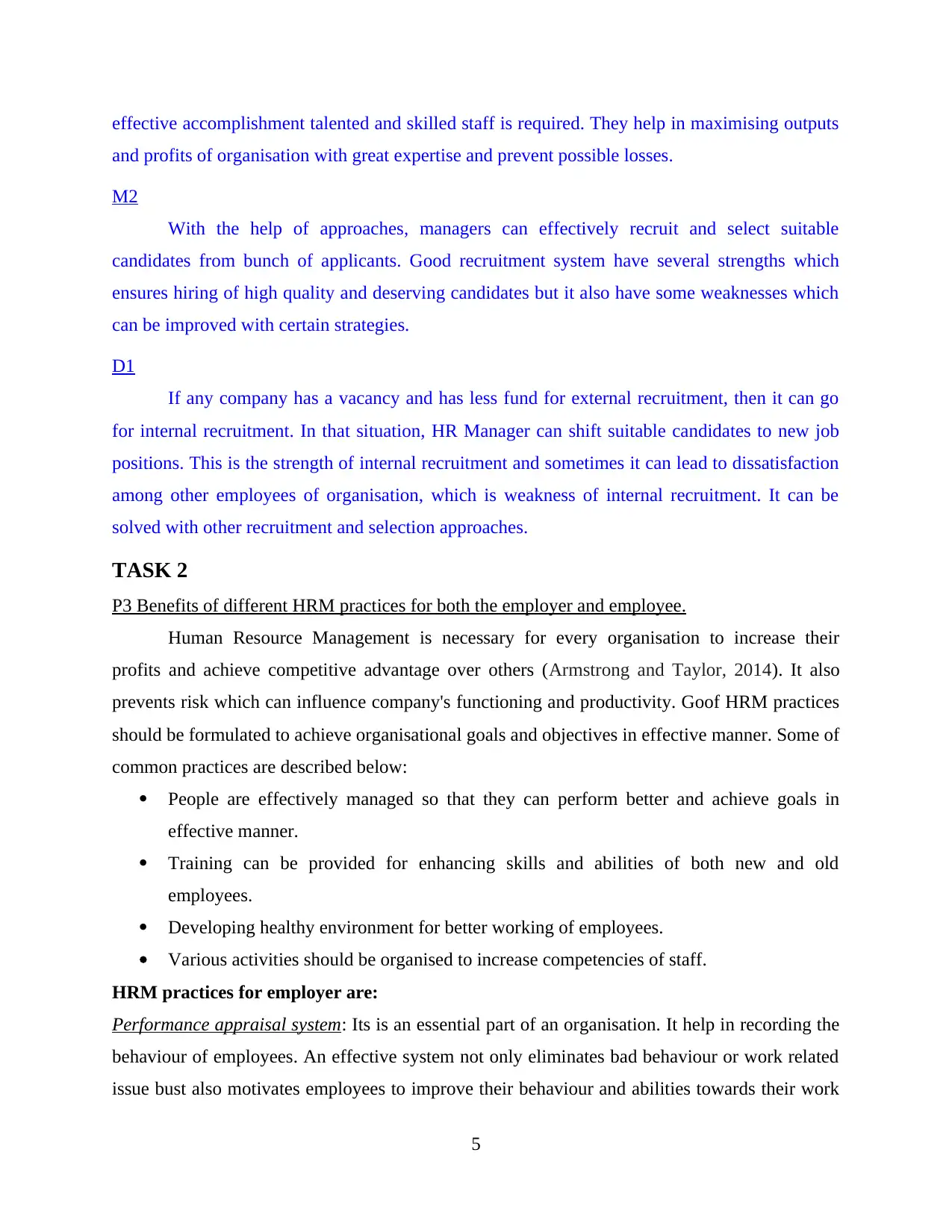
effective accomplishment talented and skilled staff is required. They help in maximising outputs
and profits of organisation with great expertise and prevent possible losses.
M2
With the help of approaches, managers can effectively recruit and select suitable
candidates from bunch of applicants. Good recruitment system have several strengths which
ensures hiring of high quality and deserving candidates but it also have some weaknesses which
can be improved with certain strategies.
D1
If any company has a vacancy and has less fund for external recruitment, then it can go
for internal recruitment. In that situation, HR Manager can shift suitable candidates to new job
positions. This is the strength of internal recruitment and sometimes it can lead to dissatisfaction
among other employees of organisation, which is weakness of internal recruitment. It can be
solved with other recruitment and selection approaches.
TASK 2
P3 Benefits of different HRM practices for both the employer and employee.
Human Resource Management is necessary for every organisation to increase their
profits and achieve competitive advantage over others (Armstrong and Taylor, 2014). It also
prevents risk which can influence company's functioning and productivity. Goof HRM practices
should be formulated to achieve organisational goals and objectives in effective manner. Some of
common practices are described below:
People are effectively managed so that they can perform better and achieve goals in
effective manner.
Training can be provided for enhancing skills and abilities of both new and old
employees.
Developing healthy environment for better working of employees.
Various activities should be organised to increase competencies of staff.
HRM practices for employer are:
Performance appraisal system: Its is an essential part of an organisation. It help in recording the
behaviour of employees. An effective system not only eliminates bad behaviour or work related
issue bust also motivates employees to improve their behaviour and abilities towards their work
5
and profits of organisation with great expertise and prevent possible losses.
M2
With the help of approaches, managers can effectively recruit and select suitable
candidates from bunch of applicants. Good recruitment system have several strengths which
ensures hiring of high quality and deserving candidates but it also have some weaknesses which
can be improved with certain strategies.
D1
If any company has a vacancy and has less fund for external recruitment, then it can go
for internal recruitment. In that situation, HR Manager can shift suitable candidates to new job
positions. This is the strength of internal recruitment and sometimes it can lead to dissatisfaction
among other employees of organisation, which is weakness of internal recruitment. It can be
solved with other recruitment and selection approaches.
TASK 2
P3 Benefits of different HRM practices for both the employer and employee.
Human Resource Management is necessary for every organisation to increase their
profits and achieve competitive advantage over others (Armstrong and Taylor, 2014). It also
prevents risk which can influence company's functioning and productivity. Goof HRM practices
should be formulated to achieve organisational goals and objectives in effective manner. Some of
common practices are described below:
People are effectively managed so that they can perform better and achieve goals in
effective manner.
Training can be provided for enhancing skills and abilities of both new and old
employees.
Developing healthy environment for better working of employees.
Various activities should be organised to increase competencies of staff.
HRM practices for employer are:
Performance appraisal system: Its is an essential part of an organisation. It help in recording the
behaviour of employees. An effective system not only eliminates bad behaviour or work related
issue bust also motivates employees to improve their behaviour and abilities towards their work
5
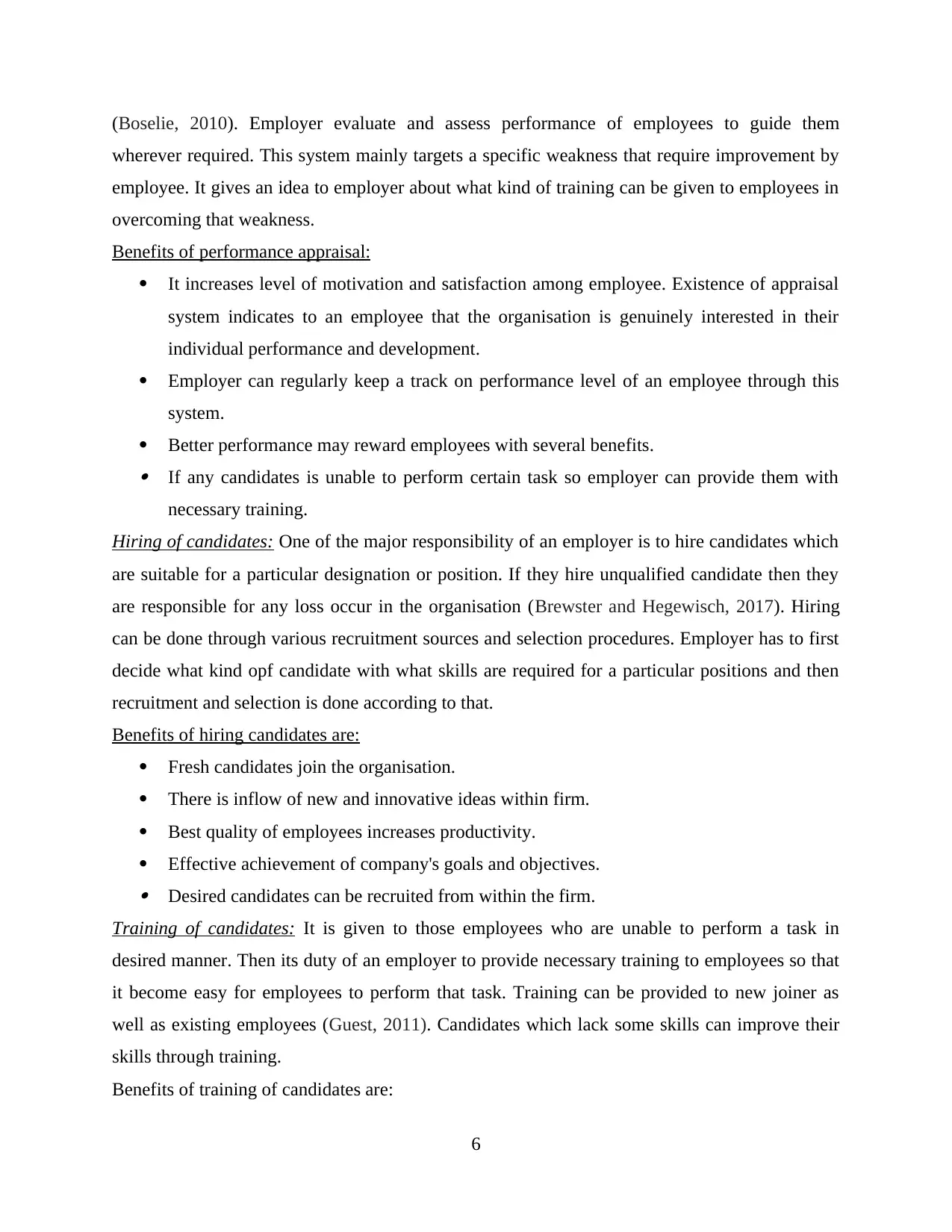
(Boselie, 2010). Employer evaluate and assess performance of employees to guide them
wherever required. This system mainly targets a specific weakness that require improvement by
employee. It gives an idea to employer about what kind of training can be given to employees in
overcoming that weakness.
Benefits of performance appraisal:
It increases level of motivation and satisfaction among employee. Existence of appraisal
system indicates to an employee that the organisation is genuinely interested in their
individual performance and development.
Employer can regularly keep a track on performance level of an employee through this
system.
Better performance may reward employees with several benefits. If any candidates is unable to perform certain task so employer can provide them with
necessary training.
Hiring of candidates: One of the major responsibility of an employer is to hire candidates which
are suitable for a particular designation or position. If they hire unqualified candidate then they
are responsible for any loss occur in the organisation (Brewster and Hegewisch, 2017). Hiring
can be done through various recruitment sources and selection procedures. Employer has to first
decide what kind opf candidate with what skills are required for a particular positions and then
recruitment and selection is done according to that.
Benefits of hiring candidates are:
Fresh candidates join the organisation.
There is inflow of new and innovative ideas within firm.
Best quality of employees increases productivity.
Effective achievement of company's goals and objectives. Desired candidates can be recruited from within the firm.
Training of candidates: It is given to those employees who are unable to perform a task in
desired manner. Then its duty of an employer to provide necessary training to employees so that
it become easy for employees to perform that task. Training can be provided to new joiner as
well as existing employees (Guest, 2011). Candidates which lack some skills can improve their
skills through training.
Benefits of training of candidates are:
6
wherever required. This system mainly targets a specific weakness that require improvement by
employee. It gives an idea to employer about what kind of training can be given to employees in
overcoming that weakness.
Benefits of performance appraisal:
It increases level of motivation and satisfaction among employee. Existence of appraisal
system indicates to an employee that the organisation is genuinely interested in their
individual performance and development.
Employer can regularly keep a track on performance level of an employee through this
system.
Better performance may reward employees with several benefits. If any candidates is unable to perform certain task so employer can provide them with
necessary training.
Hiring of candidates: One of the major responsibility of an employer is to hire candidates which
are suitable for a particular designation or position. If they hire unqualified candidate then they
are responsible for any loss occur in the organisation (Brewster and Hegewisch, 2017). Hiring
can be done through various recruitment sources and selection procedures. Employer has to first
decide what kind opf candidate with what skills are required for a particular positions and then
recruitment and selection is done according to that.
Benefits of hiring candidates are:
Fresh candidates join the organisation.
There is inflow of new and innovative ideas within firm.
Best quality of employees increases productivity.
Effective achievement of company's goals and objectives. Desired candidates can be recruited from within the firm.
Training of candidates: It is given to those employees who are unable to perform a task in
desired manner. Then its duty of an employer to provide necessary training to employees so that
it become easy for employees to perform that task. Training can be provided to new joiner as
well as existing employees (Guest, 2011). Candidates which lack some skills can improve their
skills through training.
Benefits of training of candidates are:
6
⊘ This is a preview!⊘
Do you want full access?
Subscribe today to unlock all pages.

Trusted by 1+ million students worldwide
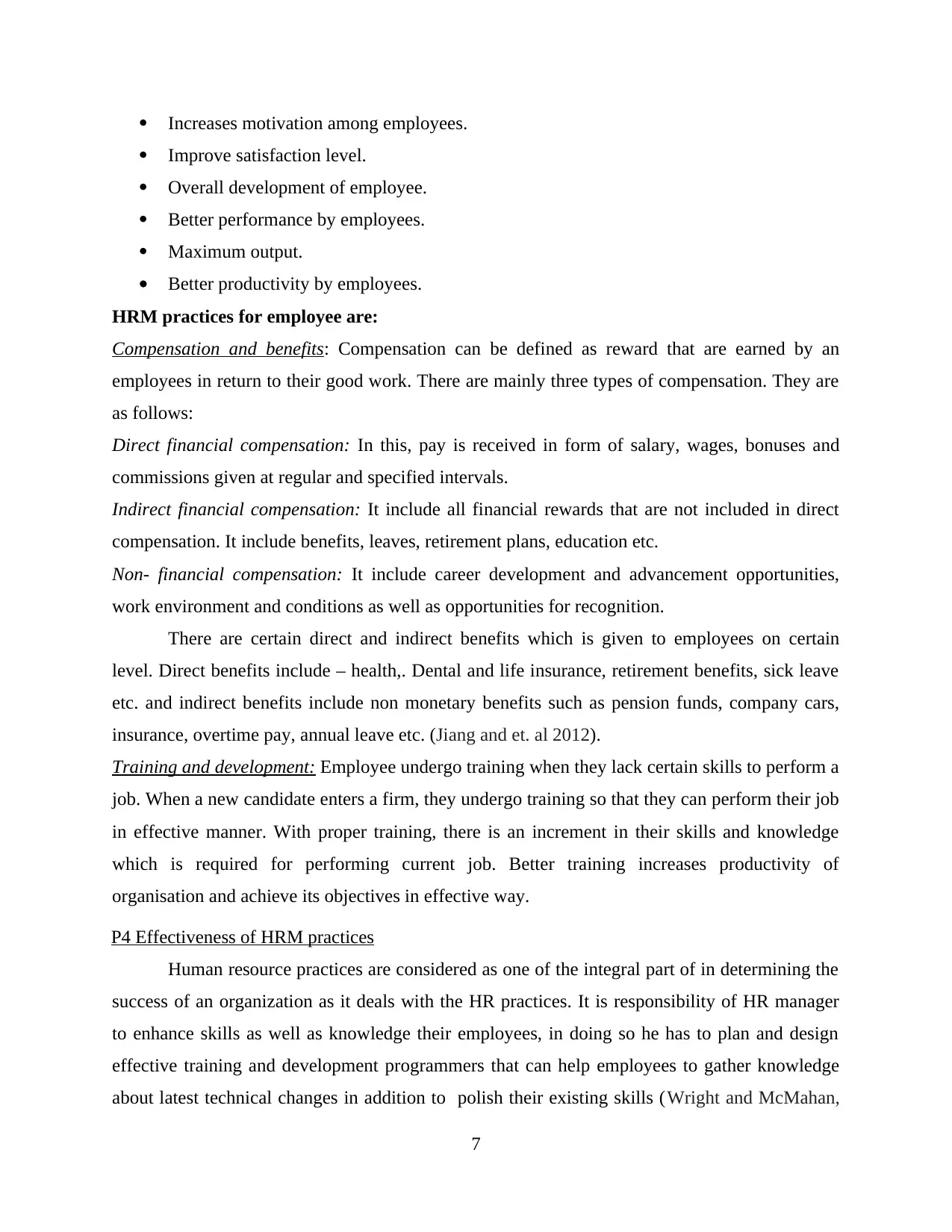
Increases motivation among employees.
Improve satisfaction level.
Overall development of employee.
Better performance by employees.
Maximum output.
Better productivity by employees.
HRM practices for employee are:
Compensation and benefits: Compensation can be defined as reward that are earned by an
employees in return to their good work. There are mainly three types of compensation. They are
as follows:
Direct financial compensation: In this, pay is received in form of salary, wages, bonuses and
commissions given at regular and specified intervals.
Indirect financial compensation: It include all financial rewards that are not included in direct
compensation. It include benefits, leaves, retirement plans, education etc.
Non- financial compensation: It include career development and advancement opportunities,
work environment and conditions as well as opportunities for recognition.
There are certain direct and indirect benefits which is given to employees on certain
level. Direct benefits include – health,. Dental and life insurance, retirement benefits, sick leave
etc. and indirect benefits include non monetary benefits such as pension funds, company cars,
insurance, overtime pay, annual leave etc. (Jiang and et. al 2012).
Training and development: Employee undergo training when they lack certain skills to perform a
job. When a new candidate enters a firm, they undergo training so that they can perform their job
in effective manner. With proper training, there is an increment in their skills and knowledge
which is required for performing current job. Better training increases productivity of
organisation and achieve its objectives in effective way.
P4 Effectiveness of HRM practices
Human resource practices are considered as one of the integral part of in determining the
success of an organization as it deals with the HR practices. It is responsibility of HR manager
to enhance skills as well as knowledge their employees, in doing so he has to plan and design
effective training and development programmers that can help employees to gather knowledge
about latest technical changes in addition to polish their existing skills (Wright and McMahan,
7
Improve satisfaction level.
Overall development of employee.
Better performance by employees.
Maximum output.
Better productivity by employees.
HRM practices for employee are:
Compensation and benefits: Compensation can be defined as reward that are earned by an
employees in return to their good work. There are mainly three types of compensation. They are
as follows:
Direct financial compensation: In this, pay is received in form of salary, wages, bonuses and
commissions given at regular and specified intervals.
Indirect financial compensation: It include all financial rewards that are not included in direct
compensation. It include benefits, leaves, retirement plans, education etc.
Non- financial compensation: It include career development and advancement opportunities,
work environment and conditions as well as opportunities for recognition.
There are certain direct and indirect benefits which is given to employees on certain
level. Direct benefits include – health,. Dental and life insurance, retirement benefits, sick leave
etc. and indirect benefits include non monetary benefits such as pension funds, company cars,
insurance, overtime pay, annual leave etc. (Jiang and et. al 2012).
Training and development: Employee undergo training when they lack certain skills to perform a
job. When a new candidate enters a firm, they undergo training so that they can perform their job
in effective manner. With proper training, there is an increment in their skills and knowledge
which is required for performing current job. Better training increases productivity of
organisation and achieve its objectives in effective way.
P4 Effectiveness of HRM practices
Human resource practices are considered as one of the integral part of in determining the
success of an organization as it deals with the HR practices. It is responsibility of HR manager
to enhance skills as well as knowledge their employees, in doing so he has to plan and design
effective training and development programmers that can help employees to gather knowledge
about latest technical changes in addition to polish their existing skills (Wright and McMahan,
7
Paraphrase This Document
Need a fresh take? Get an instant paraphrase of this document with our AI Paraphraser
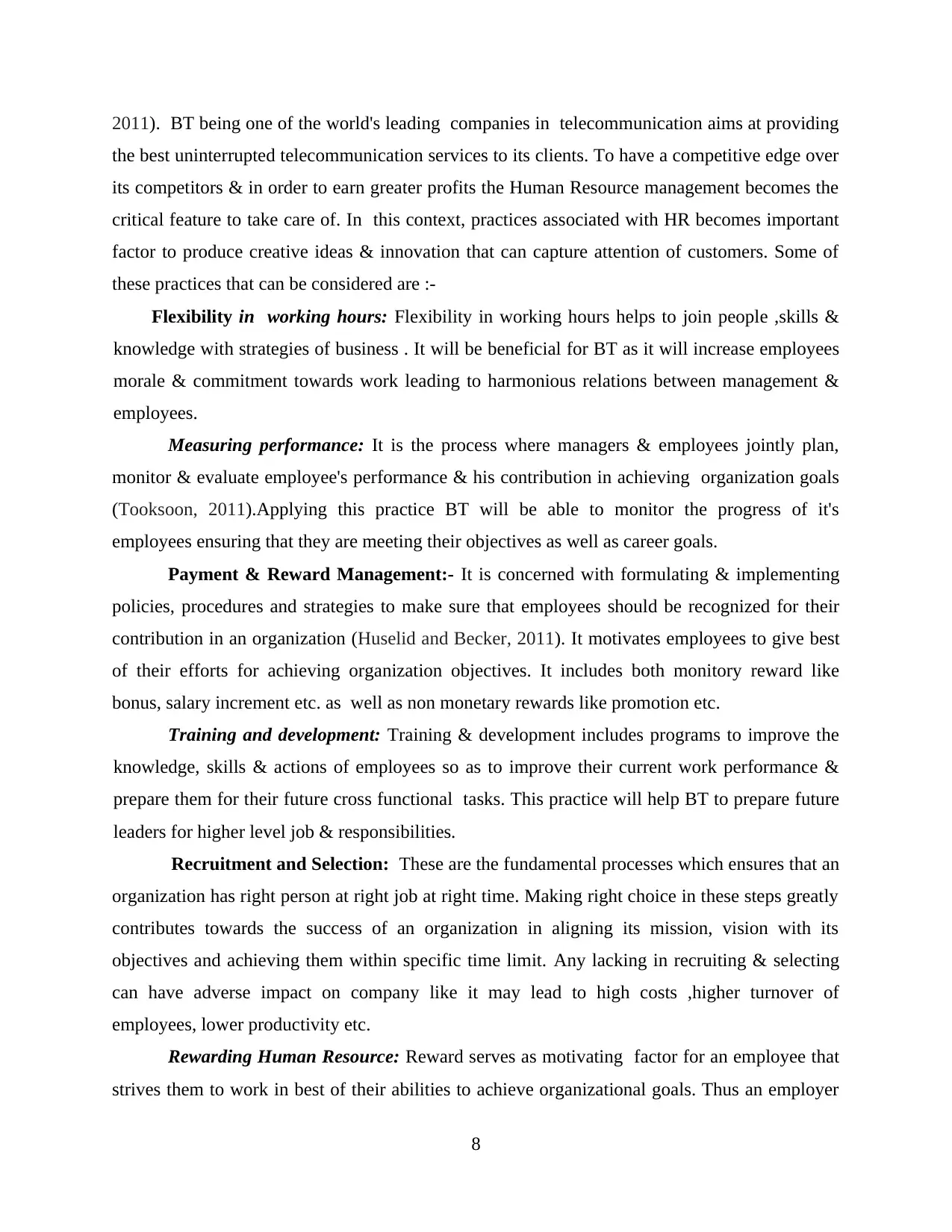
2011). BT being one of the world's leading companies in telecommunication aims at providing
the best uninterrupted telecommunication services to its clients. To have a competitive edge over
its competitors & in order to earn greater profits the Human Resource management becomes the
critical feature to take care of. In this context, practices associated with HR becomes important
factor to produce creative ideas & innovation that can capture attention of customers. Some of
these practices that can be considered are :-
Flexibility in working hours: Flexibility in working hours helps to join people ,skills &
knowledge with strategies of business . It will be beneficial for BT as it will increase employees
morale & commitment towards work leading to harmonious relations between management &
employees.
Measuring performance: It is the process where managers & employees jointly plan,
monitor & evaluate employee's performance & his contribution in achieving organization goals
(Tooksoon, 2011).Applying this practice BT will be able to monitor the progress of it's
employees ensuring that they are meeting their objectives as well as career goals.
Payment & Reward Management:- It is concerned with formulating & implementing
policies, procedures and strategies to make sure that employees should be recognized for their
contribution in an organization (Huselid and Becker, 2011). It motivates employees to give best
of their efforts for achieving organization objectives. It includes both monitory reward like
bonus, salary increment etc. as well as non monetary rewards like promotion etc.
Training and development: Training & development includes programs to improve the
knowledge, skills & actions of employees so as to improve their current work performance &
prepare them for their future cross functional tasks. This practice will help BT to prepare future
leaders for higher level job & responsibilities.
Recruitment and Selection: These are the fundamental processes which ensures that an
organization has right person at right job at right time. Making right choice in these steps greatly
contributes towards the success of an organization in aligning its mission, vision with its
objectives and achieving them within specific time limit. Any lacking in recruiting & selecting
can have adverse impact on company like it may lead to high costs ,higher turnover of
employees, lower productivity etc.
Rewarding Human Resource: Reward serves as motivating factor for an employee that
strives them to work in best of their abilities to achieve organizational goals. Thus an employer
8
the best uninterrupted telecommunication services to its clients. To have a competitive edge over
its competitors & in order to earn greater profits the Human Resource management becomes the
critical feature to take care of. In this context, practices associated with HR becomes important
factor to produce creative ideas & innovation that can capture attention of customers. Some of
these practices that can be considered are :-
Flexibility in working hours: Flexibility in working hours helps to join people ,skills &
knowledge with strategies of business . It will be beneficial for BT as it will increase employees
morale & commitment towards work leading to harmonious relations between management &
employees.
Measuring performance: It is the process where managers & employees jointly plan,
monitor & evaluate employee's performance & his contribution in achieving organization goals
(Tooksoon, 2011).Applying this practice BT will be able to monitor the progress of it's
employees ensuring that they are meeting their objectives as well as career goals.
Payment & Reward Management:- It is concerned with formulating & implementing
policies, procedures and strategies to make sure that employees should be recognized for their
contribution in an organization (Huselid and Becker, 2011). It motivates employees to give best
of their efforts for achieving organization objectives. It includes both monitory reward like
bonus, salary increment etc. as well as non monetary rewards like promotion etc.
Training and development: Training & development includes programs to improve the
knowledge, skills & actions of employees so as to improve their current work performance &
prepare them for their future cross functional tasks. This practice will help BT to prepare future
leaders for higher level job & responsibilities.
Recruitment and Selection: These are the fundamental processes which ensures that an
organization has right person at right job at right time. Making right choice in these steps greatly
contributes towards the success of an organization in aligning its mission, vision with its
objectives and achieving them within specific time limit. Any lacking in recruiting & selecting
can have adverse impact on company like it may lead to high costs ,higher turnover of
employees, lower productivity etc.
Rewarding Human Resource: Reward serves as motivating factor for an employee that
strives them to work in best of their abilities to achieve organizational goals. Thus an employer
8
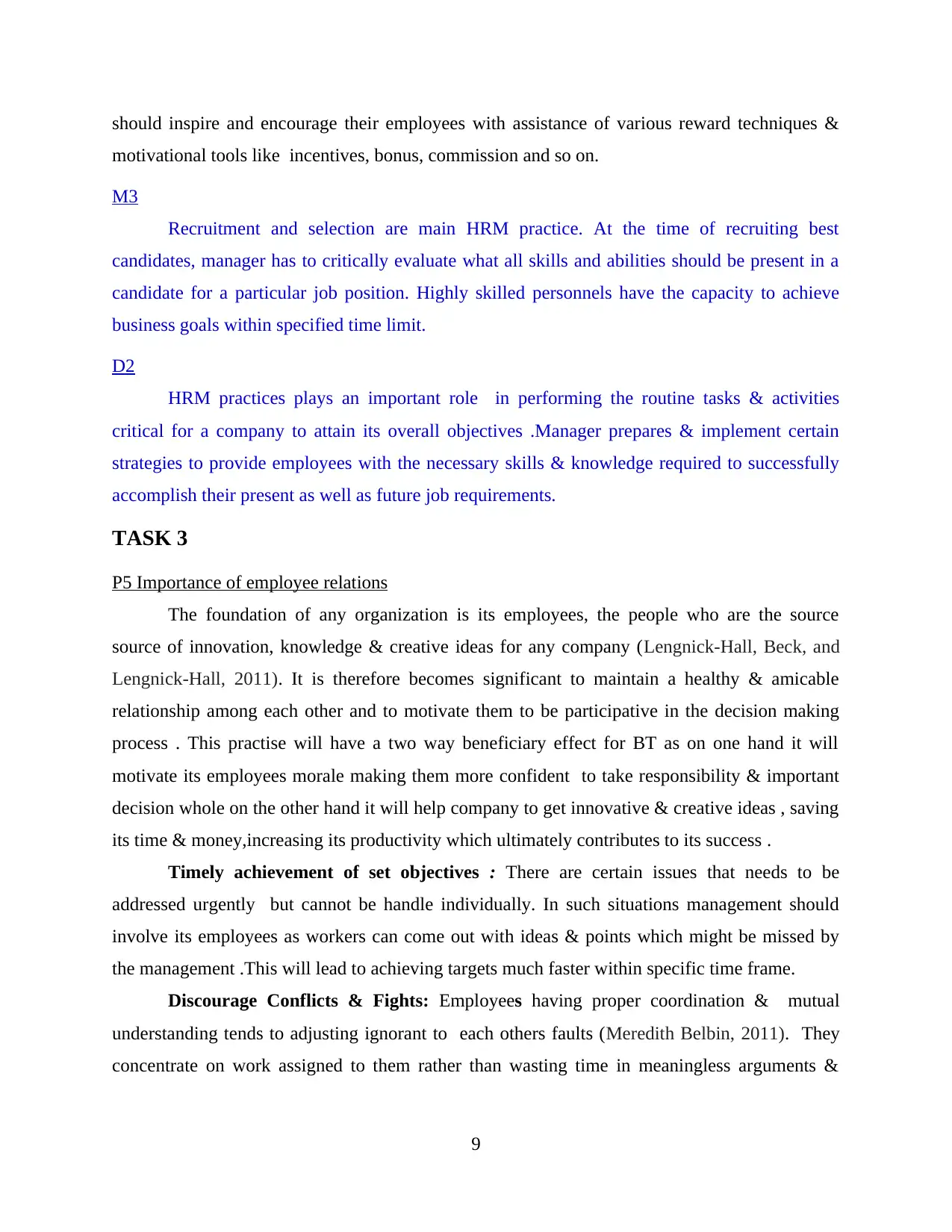
should inspire and encourage their employees with assistance of various reward techniques &
motivational tools like incentives, bonus, commission and so on.
M3
Recruitment and selection are main HRM practice. At the time of recruiting best
candidates, manager has to critically evaluate what all skills and abilities should be present in a
candidate for a particular job position. Highly skilled personnels have the capacity to achieve
business goals within specified time limit.
D2
HRM practices plays an important role in performing the routine tasks & activities
critical for a company to attain its overall objectives .Manager prepares & implement certain
strategies to provide employees with the necessary skills & knowledge required to successfully
accomplish their present as well as future job requirements.
TASK 3
P5 Importance of employee relations
The foundation of any organization is its employees, the people who are the source
source of innovation, knowledge & creative ideas for any company (Lengnick-Hall, Beck, and
Lengnick-Hall, 2011). It is therefore becomes significant to maintain a healthy & amicable
relationship among each other and to motivate them to be participative in the decision making
process . This practise will have a two way beneficiary effect for BT as on one hand it will
motivate its employees morale making them more confident to take responsibility & important
decision whole on the other hand it will help company to get innovative & creative ideas , saving
its time & money,increasing its productivity which ultimately contributes to its success .
Timely achievement of set objectives : There are certain issues that needs to be
addressed urgently but cannot be handle individually. In such situations management should
involve its employees as workers can come out with ideas & points which might be missed by
the management .This will lead to achieving targets much faster within specific time frame.
Discourage Conflicts & Fights: Employees having proper coordination & mutual
understanding tends to adjusting ignorant to each others faults (Meredith Belbin, 2011). They
concentrate on work assigned to them rather than wasting time in meaningless arguments &
9
motivational tools like incentives, bonus, commission and so on.
M3
Recruitment and selection are main HRM practice. At the time of recruiting best
candidates, manager has to critically evaluate what all skills and abilities should be present in a
candidate for a particular job position. Highly skilled personnels have the capacity to achieve
business goals within specified time limit.
D2
HRM practices plays an important role in performing the routine tasks & activities
critical for a company to attain its overall objectives .Manager prepares & implement certain
strategies to provide employees with the necessary skills & knowledge required to successfully
accomplish their present as well as future job requirements.
TASK 3
P5 Importance of employee relations
The foundation of any organization is its employees, the people who are the source
source of innovation, knowledge & creative ideas for any company (Lengnick-Hall, Beck, and
Lengnick-Hall, 2011). It is therefore becomes significant to maintain a healthy & amicable
relationship among each other and to motivate them to be participative in the decision making
process . This practise will have a two way beneficiary effect for BT as on one hand it will
motivate its employees morale making them more confident to take responsibility & important
decision whole on the other hand it will help company to get innovative & creative ideas , saving
its time & money,increasing its productivity which ultimately contributes to its success .
Timely achievement of set objectives : There are certain issues that needs to be
addressed urgently but cannot be handle individually. In such situations management should
involve its employees as workers can come out with ideas & points which might be missed by
the management .This will lead to achieving targets much faster within specific time frame.
Discourage Conflicts & Fights: Employees having proper coordination & mutual
understanding tends to adjusting ignorant to each others faults (Meredith Belbin, 2011). They
concentrate on work assigned to them rather than wasting time in meaningless arguments &
9
⊘ This is a preview!⊘
Do you want full access?
Subscribe today to unlock all pages.

Trusted by 1+ million students worldwide
1 out of 20
Related Documents
Your All-in-One AI-Powered Toolkit for Academic Success.
+13062052269
info@desklib.com
Available 24*7 on WhatsApp / Email
![[object Object]](/_next/static/media/star-bottom.7253800d.svg)
Unlock your academic potential
Copyright © 2020–2025 A2Z Services. All Rights Reserved. Developed and managed by ZUCOL.





